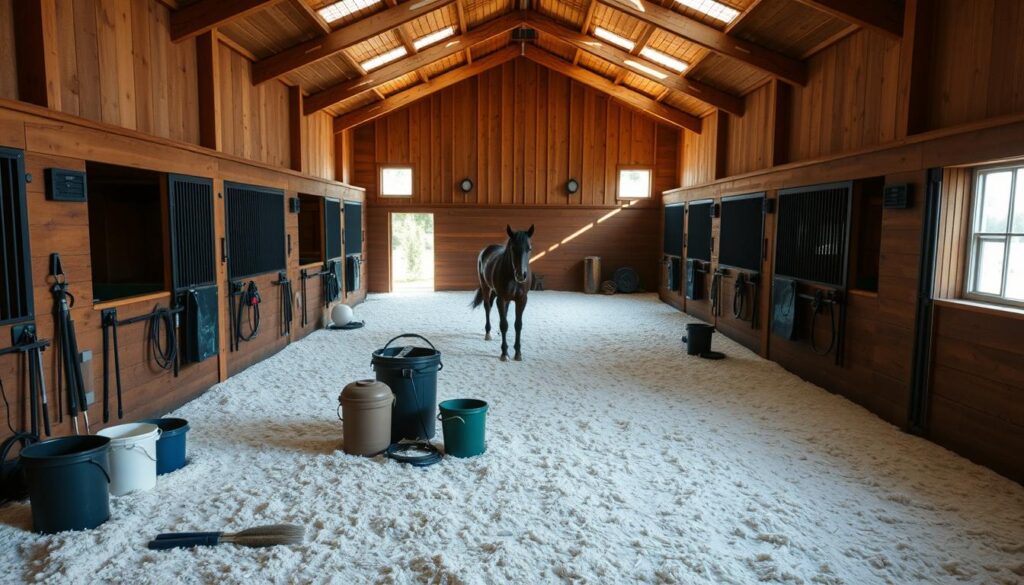Did you know 90% of boarding facilities don’t meet all daily care standards recommended by equine experts? Proper routines aren’t just about comfort—they’re vital for preventing health issues and ensuring long-term well-being. Whether you’re new to equine management or refining existing practices, a structured approach makes all the difference.
This guide breaks down the essentials every stable should prioritize. From balanced nutrition to clean water access, we’ll explore how simple, consistent habits protect your animals and streamline operations. You’ll also learn why grooming and stall maintenance matter just as much as feeding schedules.
We’ve combined insights from veterinarians and seasoned barn managers to create a practical framework. No jargon, no fluff—just actionable steps tailored for Canadian climates and facilities. Ready to build trust with clients and keep your herd thriving? Let’s dive in.
Key Takeaways
- A daily checklist ensures critical tasks like feeding and hydration aren’t overlooked.
- Clean stalls and grooming routines directly impact animal health and safety.
- Expert-backed strategies help adapt care to seasonal challenges in Canada.
- Consistency benefits both newcomers and experienced handlers.
- Upcoming sections detail time-saving tips for facility managers.
Introduction: Why Daily Horse Care Matters
Routine isn’t just a luxury—it’s oxygen for these majestic animals. Studies show structured daily habits reduce anxiety by 40% and lower colic risks. Without predictability, even minor changes can trigger digestive issues or behavioral spikes.
Predictability Equals Peak Performance
Consistency turns chaos into calm. Animals thrive when meals, exercise, and health checks happen like clockwork. Barns that stick to schedules see fewer injuries and smoother herd dynamics.
For example, one Alberta facility cut emergency vet calls by 55% after implementing timed turnout and feeding. Staff now spot subtle changes—like a skipped meal or stiff gait—within hours.
Blueprint for Boarding Success
Top-tier stables don’t wing it. They create clear protocols for:
- Feeding times (with measured portions)
- Hydration checks every 4-6 hours
- Daily hoof inspections and coat assessments
| Consistent Routine | Inconsistent Approach | Impact |
|---|---|---|
| Fixed meal schedule | Variable feeding times | +32% better digestion |
| Daily health logs | Sporadic checks | 67% faster issue detection |
| Structured turnout | Random pasture access | 41% fewer injuries |
Transparency builds client trust. Share your daily logs—owners appreciate seeing their animal’s water intake or grooming notes. It transforms “boarding” into partnership.
Essential Daily Horse Care Tasks
Consistent daily routines are the backbone of equine well-being. Breaking tasks into clear steps ensures nothing slips through the cracks—especially during harsh Canadian winters when hydration and nutrition matter most.
Managing Feed and Fresh Water
Start by inspecting hay for mold or dust—poor quality feed causes respiratory issues. Measure portions using weight-based calculations, not visual guesses. Experts recommend 1.5-2% of body weight daily.
Water sources need attention every 4-6 hours. Scrub buckets with vinegar weekly to prevent slime buildup. Frozen troughs in winter? Install heated units or break ice twice daily.
| Proper Practice | Risk of Neglect | Outcome |
|---|---|---|
| Clean buckets twice daily | Dirty containers | 32% fewer contaminants |
| Scheduled hay inspections | Mold exposure | +41% digestion efficiency |
| Timed feedings | Irregular meals | 55% less colic risk |
Performing Daily Visual Health Checks
Walk pastures and stalls each morning. Look for limping, swollen joints, or uneaten meals. Record findings in a shared log—vets say this checklist approach catches 68% of issues early.
Watch for subtle changes: Is that usually energetic gelding lagging behind? Does a mare’s coat look dull? Address concerns within 4 hours to prevent escalation. Inspect turnout areas for debris or uneven footing during morning checks.
horse care checklist for Boarding Facilities
A well-maintained barn isn’t just about aesthetics—it’s a frontline defense against preventable injuries. Daily protocols keep animals healthy and operations running smoothly.

Assessing Stalls, Pastures, and Shelter Safety
Inspect stalls each morning for protruding nails, broken boards, or loose latches. Uneven flooring causes 23% of pasture-related strains—sweep debris and fill holes promptly.
Check shelters before extreme weather hits. Reinforce roofs in snow-prone areas and ensure ventilation systems work. One Ontario facility reduced respiratory problems by 38% after upgrading airflow.
| Practice | Frequency | Benefit |
|---|---|---|
| Stall inspections | Daily | Prevents injuries |
| Pasture sweeps | Twice weekly | Reduces debris risks |
| Shelter checks | Before storms | Averts structural issues |
Maintaining Hygiene and Clean Bedding
Ammonia buildup from soiled bedding irritates lungs. Replace ⅓ of stall bedding daily—full cleanouts every 3-4 days work best in humid climates. Use dust-free shavings or straw.
Disinfect water buckets and feed tubs weekly. Rotate pasture areas to let grass recover. A Manitoba barn cut parasite infections by 52% using this rotation strategy.
Timely maintenance saves time long-term. Fix leaky roofs before mold spreads. Repair fences promptly to avoid costly rebuilds later.
Nutrition, Hydration, and Supplement Strategies
What separates a thriving animal from one merely getting by? Often, it’s the quality of their fuel. Proper feeding practices and hydration systems form the foundation of vitality—especially in Canada’s variable climate.
Establishing a Balanced Diet with Hay & Grains
High-quality hay should make up 60-70% of daily intake. Mix timothy or orchard grass with small grain portions for energy. Supplements like salt blocks or omega-3 additives address regional forage deficiencies. A Quebec stable boosted coat shine by adding flaxseed to morning meals.
Rotate pasture areas to maintain nutrient-rich grazing. Store hay and bedding separately—dust from soiled materials contaminates feed. Regular deworming supports nutrient absorption; consult your vet for location-specific schedules.
Ensuring Constant Access to Fresh, Clean Water
Hydration impacts everything from digestion to joint function. Check troughs twice daily for debris or algae. In winter, heated buckets prevent ice formation—a common issue in Prairie provinces.
Automatic waterers save time but require weekly scrubbing. One Alberta ranch reduced colic cases by 30% after installing flow meters to track intake. “Clean water access is non-negotiable,” says Dr. Emily Torres, a Calgary equine specialist. Adjust diets if animals drink less during temperature swings.
Routine Health and Veterinary Maintenance
Behind every healthy animal is a proactive care strategy. Regular checkups and preventative measures keep small issues from becoming emergencies. Let’s explore how structured veterinary partnerships safeguard your herd’s well-being through every season.
Scheduling Regular Vet and Farrier Visits
Veterinarians recommend checkups every 6 months—more often for senior animals or those with chronic conditions. Farriers should trim hooves every 6-8 weeks to prevent cracks and imbalances. “Catching laminitis early can save months of recovery,” notes Dr. Liam Carter, an Ontario equine specialist.
| Service | Frequency | Key Benefit |
|---|---|---|
| Dental exams | Annual | Prevents chewing issues |
| Vaccinations | Bi-annual | Reduces disease spread |
| Hoof care | 6-8 weeks | Avoids lameness |
Implementing Preventative Care and Vaccinations
Core vaccines like rabies and tetanus protect against fatal illnesses. Deworming schedules vary by region—Prairie facilities often treat parasites quarterly due to pasture density. Daily grooming sessions help spot skin abnormalities early.
Monitoring Hoof Health and Dental Care Needs
Weather plays a key role in hoof maintenance. Wet conditions soften tissues, while frozen ground increases concussion risks. Provide minerals like zinc and biotin to strengthen keratin. Dental floats every 12 months ensure proper grinding of fibrous feeds.
Cleaning tools after each use prevents cross-contamination. A British Columbia ranch reduced abscesses by 44% using antiseptic hoof picks. Pair these efforts with balanced nutrition for lasting results.
Grooming, Hoof, and Dental Care Essentials
What transforms a good grooming session into a wellness boost? It’s not just about shine—it’s your first line of defense against hidden health needs. Simple daily routines build trust while catching issues before they escalate.

Daily Grooming Techniques for a Healthy Coat
Start with a stiff brush to loosen dirt, then switch to soft bristles for polishing. Pay attention to sweat-prone areas like the girth zone. A quick mane detangling prevents painful knots. Web sources confirm: 10 minutes of brushing boosts circulation and distributes natural oils.
Skin inspections matter most. Run your hands along the body while grooming—lumps or heat spikes signal needs for vet attention. Don’t skip the legs! Mud buildup here often hides minor cuts.
Routine Hoof Trimming and Dental Exams
Schedule farrier visits every 6-8 weeks. Rocky Canadian terrain wears hooves unevenly—professional trims prevent cracks. “Neglected feet lead to costly lameness,” warns Manitoba farrier Jake Reynolds.
Dental checks catch sharp edges that hinder chewing. Annual floats smooth teeth surfaces. Pair exams with quality supplements: omega-rich oils support hoof growth, while calcium blends strengthen molars.
| Seasonal Grooming Adjustments | Tools Needed | Benefit |
|---|---|---|
| Winter | Shedding blade | Removes thick undercoat |
| Summer | Fly spray applicator | Reduces insect irritation |
| Spring/Fall | Detangler spray | Eases mane maintenance |
Small changes make big differences. Swap brushes when coats thicken in November. Track hydration levels during heat waves—dry skin needs extra conditioning. Always consult your vet before adding new supplements to routines.
Barn Chores and Facility Upkeep
A well-organized barn isn’t just tidy—it’s a shield against preventable health risks. Daily upkeep routines protect animals from infections while creating a safer workspace for handlers. Let’s explore how smart maintenance habits keep operations running smoothly.
Maintaining Clean Stalls and Equipment
Start each morning by removing soiled bedding and scrubbing water buckets. Use vinegar solutions to disinfect surfaces without harsh chemicals. Inspect stall walls for splinters—rough edges cause 28% of minor injuries during feeding.
Rotate pitchforks and wheelbarrows weekly to check for cracks. Store tools in designated racks to prevent tripping hazards. “Clean equipment lasts longer and reduces cross-contamination risks,” notes a Manitoba stable manager.
Efficient Management of Manure and Waste
Remove droppings from paddocks twice daily to limit parasite spread. Compost piles should sit 100+ feet from barns to avoid attracting pests. Frozen manure? Sprinkle sand on icy pathways to prevent slips.
Regular waste checks help spot health issues early. Undigested hay in manure signals possible teeth problems. Watery stools might indicate colic—contact your vet immediately if spotted.
| Task | Frequency | Key Benefit |
|---|---|---|
| Stall disinfection | Daily | Reduces ammonia exposure |
| Tool inspections | Weekly | Prevents equipment failure |
| Pasture cleanups | Every 4 hours | Lowers parasite counts |
Schedule farrier visits during quieter mornings—clean aisles make hoof work safer. Document all findings in shared logs to track recurring issues. A Quebec facility reduced colic cases by 37% after implementing these steps.
Seasonal Adjustments and Special Care Considerations
Canada’s dramatic climate shifts demand smart, adaptable management strategies. Proactive adjustments keep animals comfortable year-round while preventing weather-related health risks. Let’s explore how to fine-tune routines as temperatures swing from -30°C winters to humid summer heatwaves.
Adapting Care for Weather and Temperature Changes
Monitor temperature fluctuations closely—sudden drops or spikes strain metabolism. Increase hay portions by 15-20% in winter to fuel internal heating. Summer demands shade access and electrolyte supplements to replace lost minerals.
- Install heated water systems to prevent ice formation
- Rotate turnout schedules to avoid midday heat
- Adjust hoof trimming frequency for muddy or frozen ground
Regular exams during seasonal transitions help track weight changes and coat condition. A Saskatchewan study found facilities conducting fall health checks reduced winter-related colic by 29%.
Implementing Blanketing and Shelter Enhancements
Blanketing isn’t one-size-fits-all. Use waterproof sheets during rainy springs and insulated styles for Arctic blasts. Remove blankets daily to check for rubs or moisture buildup.
| Season | Shelter Upgrade | Benefit |
|---|---|---|
| Winter | Windbreak panels | Reduces chill factor |
| Summer | Ventilation fans | Improves airflow |
| Spring | Drainage trenches | Prevents muddy hooves |
Track weight monthly—animals burn more calories staying warm. “Winter coats can hide condition loss,” warns Dr. Rachel Nguyen of Alberta Equine Clinic. “Palpate ribs every two weeks.”
Conclusion
Building trust with your herd begins with thoughtful daily rhythms. From balanced meals to stall safety checks, each task strengthens their well-being. Regular grooming sessions and pasture inspections become moments to deepen companionship while catching issues early.
Consistency in routines pays dividends. Facilities prioritizing vaccinations and health logs see fewer emergencies. Clean water access and seasonal adjustments keep animals thriving through Canada’s extremes. These efforts transform basic maintenance into genuine partnership.
Remember—structured care benefits everyone. Herds stay energetic for riding and training. Clients notice meticulous attention to different types of needs. Review your approach monthly, adapting to new challenges while celebrating progress.
When done right, daily checks aren’t chores—they’re investments. Healthy animals and smooth operations speak louder than any brochure. Keep refining your methods, and watch both your herd and reputation flourish.

